What are Androids dreaming of?
... or a review of the Samsung GALAXY Nexus smartphone.
Good day, friends!
I present to you an overview of the device, which marked the release of the evolution of the most common currently in the world of mobile OS Android. GALAXY Nexus is the second joint development of two international giants Samsung Electronics and Google, as well as the world's first smartphone based on Android 4.0 Icecream Sandwich. Many were waiting for her, many wanted her and, from the end of last year, many can touch the green robot of the latest version, which was designed to combine the previously scattered mobile and tablet OSes of Google. Did they cope with this task? How good is this member of the GALAXY family? Read about all this and much more under the cat.

It all started with the Nexus One, which Google created together with HTC. The device entered the market in 2010 and, like subsequent models, was intended to become the locomotive of the progress of Android gadgets: it was the first smartphone running Android 2.1. The Nexus One model was released primarily in order to spur the market and mark a new stage in the development of the green robot OS, so at the time of its release it was not planned to continue this series with new models. However, contrary to expectations and initial ideas, at the end of 2010 saw the light of a new joint development of Google and Samsung Electronics - Nexus S.
There is a curious version among bloggers about where the name “Nexus” came from: the daughter of the famous American science fiction writer, one of the founding fathers of the cyberpunk trend, Philip Dick, believes that this is a reference to one of his novels “Do Androids Dream of Electric Owls?” , where the androids of the Nexus-6 model appear.
The history of the Nexus series continues, finding embodiment in the new Samsung GALAXY Nexus model. Let's take a closer look at it.
We are forced to miss the story about the configuration of the device, since we got only a test sample without a beautiful box, instructions and accessories. But, according to insider information, in a standard package with GALAXY Nexus you are guaranteed to find:
- Samsung GALAXY Nexus smartphone
- Charger
- Stereo headset
- USB cable
- Quick Start Guide
The first thing that catches your eye when you pick up a GALAXY Nexus in your hands - the impressive size of the screen, as well as the complete absence of any buttons above or below it: the screen is a monolithic touchscreen with a size of 4.65 inches. Perhaps this is the maximum reasonable screen size for a smartphone (for fans of "bigger", we already have a 5.3-inch GALAXY Note in stock, or GALAXY Tab tablets for every taste and size). The edges of the device’s body are traditionally rounded, and it is gracefully curved, which positively affects the appearance and how it lies in the hand.

On the sides of the screen are thin black frames. A little wider the frame frames the bottom edge of the smartphone, and on the top there is a front camera, a speaker for conversation and light / proximity sensors.

The back side of the GALAXY Nexus is no less concise: the battery (1750 mAh) and the SIM card slot are hidden under the finest ribbed cover, which is very pleasant to the touch (like rubberized), and also very easy to take off and put on back. At the top in the center is the camera eye and a LED backlight underneath, in the lower part of the body is a multimedia speaker grid.
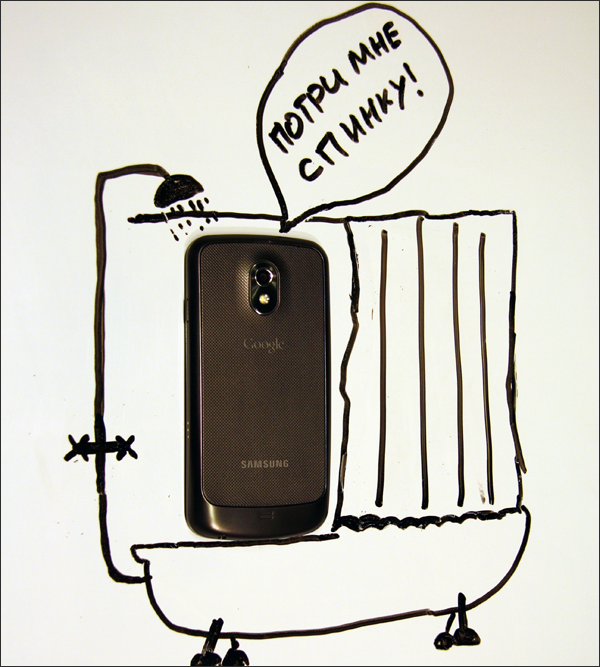
At the ends of the device: on the left is the double “rocker” key to control the sound volume, on the right is the on / off / lock button and gold-plated contacts for connecting the docking station, the top is empty, and the bottom, microUSB and 3.5 mm are located on the thickest end connectors.


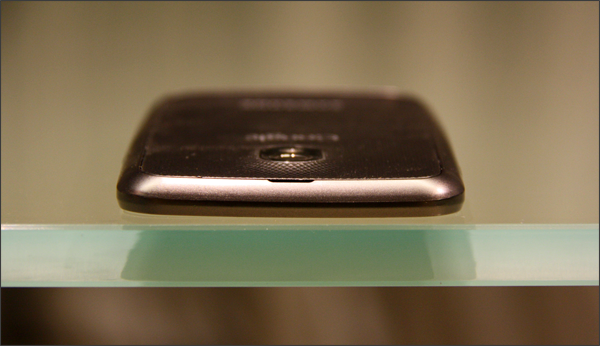

A light click on the power button on the right side of the smartphone - and the screen lights up with all its 16 million colors. Actually, what our gaze fell on the first - from that we begin the story.

The screen is impeccably good, as in all key Samsung mobile devices sold over the past three years. The company made it a rule to adhere to the highest standards of image quality, and it definitely does. In fact, almost every new gadget boasts a small but pleasant improvement on the screen. The same thing happened with the GALAXY Nexus: its HD Super AMOLED display contains as many as 921,000 pixels, the pixel density index (the number of pixels per inch) is ~ 316 ppi. Resolution 1280x720 gives a much more comfortable and natural display. At the same time, the device supports shooting and playing Full HD video. With viewing angles and the saturation of black, there are no complaints either. The margin of brightness of the device is large: at maximum settings in a bright room, looking at the screen is quite difficult. It must be assumed that on a clear summer day the display will not fail with a clear image. By the way, the smartphone has an extremely convenient and adequate automatic adjustment of the screen brightness, which almost instantly sets the optimal parameters when changing external lighting.
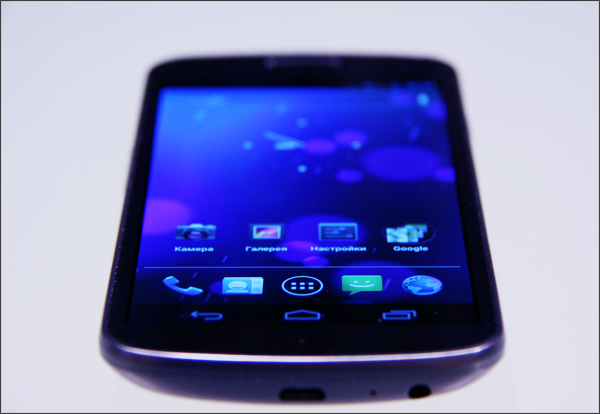
The most important purpose of the new Nexus model is, no less, no less - market promotion of the latest operating system, which is equally suitable for new smartphones and tablets - Android 4.0 Icecream Sandwich. The OS is presented in its original form - without any add-ons and shells from the manufacturer. Not found in the device and branded applications from Samsung - only those that are present in the OS by default.
As we recall, until the spring of 2011, the development of tablet devices went with a creak due to the fact that manufacturers were forced to integrate into the new gadgets the smartphone OS Android 2.x, which was not very suitable for this. In the spring of 2011, the long-awaited version of Android 3.0 Honeycomb special for tablet devices was released. This gave a new round of development of “tablets”, but did not help the development of smartphones. It is the fourth version of the android that is designed to save Google from the fragmentation of the platform that has gotten sore.
The fact that Android 4.0 logically flows out of the previous Honeycomb did not come as a surprise to anyone. On the one hand, this is good: the familiar design and interface only simplify the task of learning new things for the average user. On the other hand, not all users are satisfied when, instead of really new, they only palm off the dopped old ...
PS: who still do not know, the official Android 4.0.3 firmware for Samsung GALAXY S II has already been released.
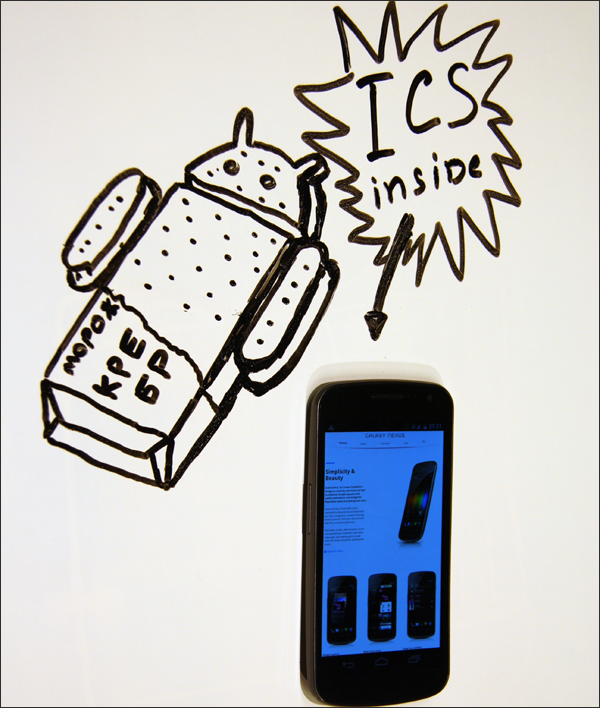
1) Naturally, the appearance of the system. All icons, fonts, visual effects - everything is new and really pleasing to the look, unlike ardent fighters with aesthetics and harmony in the face of previous versions of the green robot. Big breakthrough for Google!
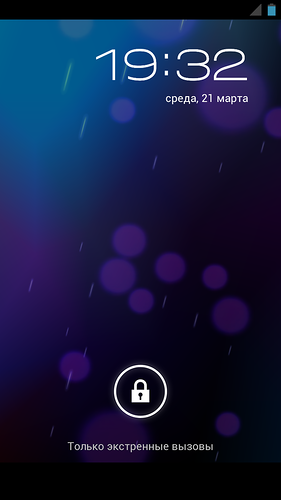
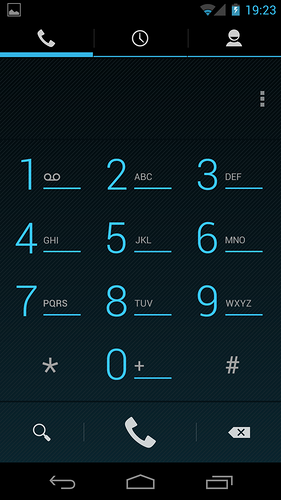
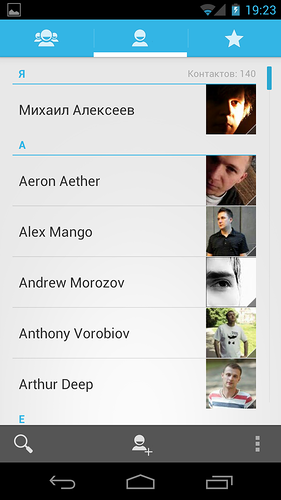
2) The interface has acquired a number of desired and truly necessary elements. The basis of smartphone navigation is now built on three buttons: “Back”, “Home”, “Running applications”. All of them are part of the Android 4.0 software shell (in connection with which it was decided to completely abandon the hardware buttons).

In running applications, you can now not only see the list of programs running in the background, but also close unnecessary ones by simply shifting their shortcut left or right. When required, next to the three main navigation buttons, another appears - “Auxiliary menu”. It replaces the "Context Menu" button, which Google recently decided to completely abandon. The All Applications button is now located on the main screen, exactly above the Home button.

3) One of the most anticipated innovations of the fourth android is the ability to collect program and game shortcuts into folders. Unfortunately, in the list of all applications the mess remains unchanged: the new functionality with creating folders applies only to 5 desktops available to the user. Folders can also be named.
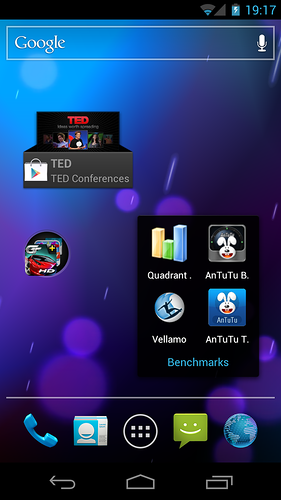
4) The access to the list of widgets has been simplified: now they are hiding under the corresponding tab next to the “Applications”. Some of them even have a variable size, which allows them to fit the desired screen configuration. Right there, in the upper right corner, a shortcut from the Android Market settled, which is also very convenient.




5) The ability to remove applications has become easier: now there is no need to go into the settings every time and look for the desired program: just hold your finger on the shortcut and drag it into the basket popping up at the top of the screen.
6) It is worth paying special attention to the process of unlocking the screen and its functionality. Moving the icon with the lock to the right, the device will actually unlock. With a similar movement to the left, you immediately get to the camera menu. But this is not the most interesting way to unlock the screen: Android 4.0 allows you to do this by recognizing the face of the owner: a kind of “face control”. The procedure is simple: a face photo is taken on the front camera. When you turn on the device, it automatically starts looking for a familiar face. If the face cannot be found or correctly recognized, the device will ask for a digital password, or, optionally, the so-called unlock pattern (the line that you draw with your finger in advance and which you will need to repeat later to unlock the device).
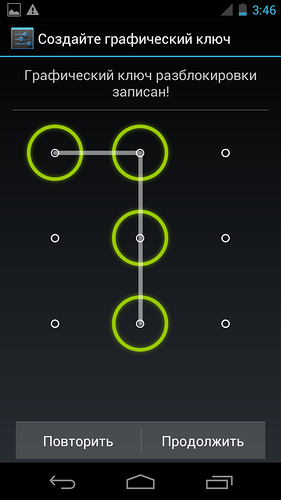
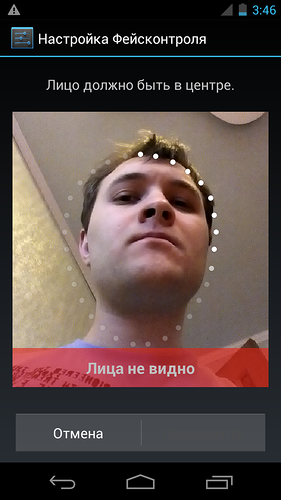
7) The notification line has also changed: from now on, you can immediately go to the settings, and instead of the “Clear” button, which automatically deleted all accumulated notifications, you now have the opportunity to selectively delete lines, “scattering” them with gestures left and right.

8) In the Settings, the “Data Transfer” item appeared, in which you can completely take control of your mobile traffic, put restrictions on monthly downloads, determine what types of connections can work in the background, and so on. Wi-Fi Direct and NFC also worked well, allowing bypassing access points to quickly and conveniently exchange data with other devices.

By the way, not so long ago there were curious “smart” NFC tags, pre-programmed for the needs of smartphone users. For example, you get in your car, attach the smartphone to the NFC tag glued to the dashboard, after which the hands-free mode is automatically activated on the phone, the speakerphone and the GPS navigator turn on. Or you come to the office: a light touch of an NFC tag by a smartphone - and your mobile device goes into vibro mode, the mail and organizer applications are launched. How it works, you can watch the video (attention, English):
9) The “Pocket” browser has undergone many changes, which is why it has become really smart and convenient for online surfing. Now you can keep open up to 16 tabs, there is a preview available, and the download speed and page display simply can not but rejoice: the difference is really tangible!
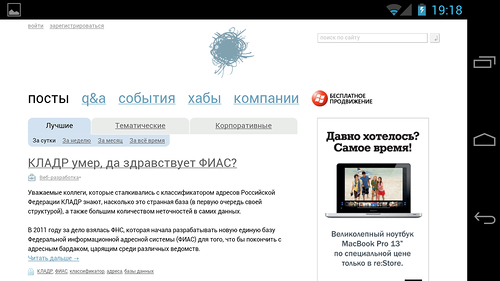

10) All standard Google-applications were carefully redesigned and improved: GMail (added a line for quick sending messages, improved preview), Google+, Youtube, Navigation, Calendar, Music player, etc.
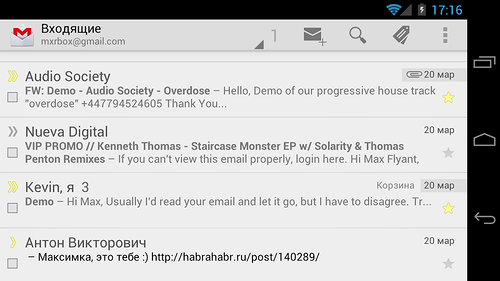
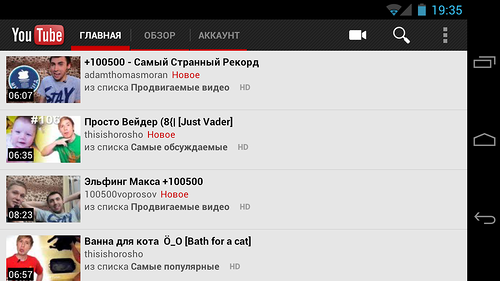
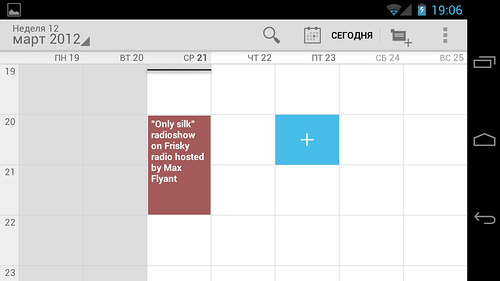

11) FOTA (Firmware-over-the-Air) technology, so desirable for most inexperienced users, was very pleased: now it will be possible to update the firmware of a smartphone or tablet “over the air”, in automatic or manual mode. For even greater convenience, push messages will be sent to the device informing that a new version of the firmware for the device has been released. By the way, only new modules will be loaded to the already installed firmware.
12) At GALAXY Nexus, it was decided to abandon the USB Mass Storage data transfer protocol. The new alternative protocol MTP (Media Transfer Protocol) does not cause any dissonance in use and absolutely correctly copes with the transfer of data of any kind.
13) A new font - Roboto is now adopted by Android 4.0 and will be used in all subsequent versions of the OS. The company believes that it is the most optimal and readable in devices with HD-screen resolution.
Benchmark, it's your time!
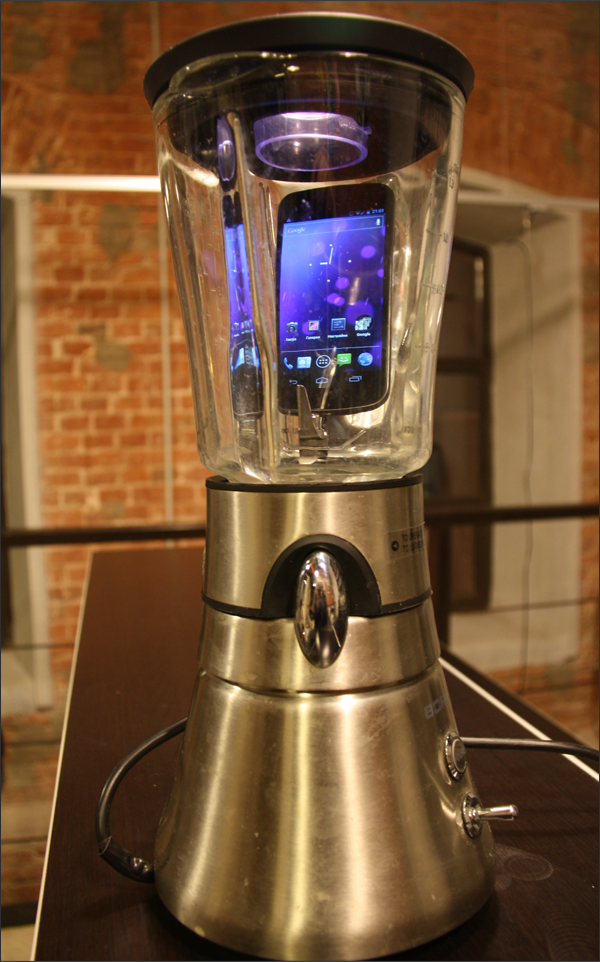
The performance result in Quadrant Standard was 2073, which is quite at the level of a modern mobile device.

A similar run of the smartphone in a more sensible and comprehensive AnTuTu Benchmark showed a result of 6124, with which Samsung GALAXY Note was only slightly inferior.

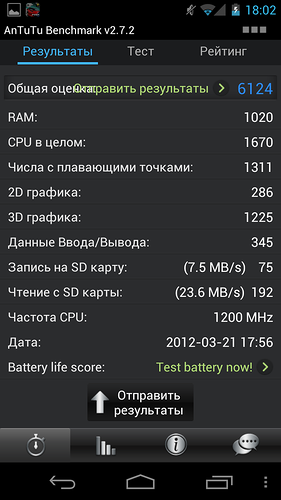
Vellamo Benchmark, designed to test devices for browser speed, showed neither more nor less, the third result among all smartphones based on Android OS ever tested there.

The 5 megapixel camera significantly loses the same GALAXY S II with 8 megapixels on board. This is noticeable in the pictures, but in general the gadget copes with its functions of quick photography of something properly. And the shooting speed, as well as saving photos, is now really quick, thanks to the new firmware. Convenient camera interface, sensible tracking focus and many settings positively affect the final opinion about the camera.




The panoramic shooting function is now integrated at the OS level, and the pictures come with a zero shutter delay: even the flagship GALAXY S II cannot boast of this. The maximum resolution of pictures is 2592x1936 pixels. Examples of photos can be seen below.










As for video shooting, here we have a resolution of up to 1920x1080 at 30 frames per second with progressive scan. "Full" Full HD.
With video playback, not everything went smoothly: as it turned out, the very popular now mkv container with a standard player is not perceived at all. But any mp4-clips in Full HD are played with a bang. In general, a third-party omnivorous video player, one way or another, is required.
The music player pleased with its attractive appearance, as well as the ability to customize the equalizer for itself, or set one of the available modes. By the way, the sound of the smartphone is really worthy, which will please any music lover.

Games. Having run through several bestsellers of the mobile world, I got a real pleasure. Angry Birds, Fruit Ninja, various Gameloft ports, and for dessert - Sims Freeplay and GTA 3!
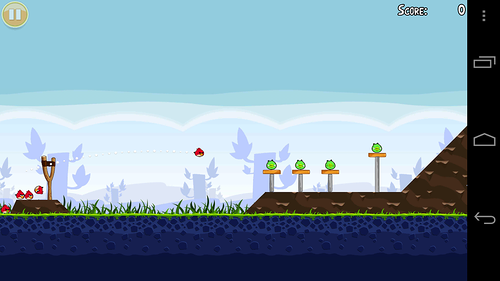




Just think: 10 years ago, with wild lags on my home PC, I cut into the first three-dimensional version of my favorite toy, and now I just take my smartphone out of my pocket and play it in the subway on the way to work ... and without any brakes! Hail Technical Progress ...
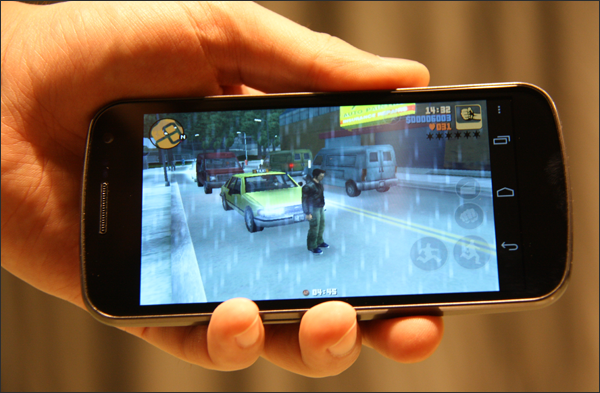
Platform:
Дисплей:
Процессор:
Память:
Камера:
Видео:
Подключения:
+ Slim stylish case, light weight
+ Large screen, high resolution and brightness, excellent image quality
+ The ability to create panoramic photos and record video in Full HD
+ Performance sufficient for comfortable work and entertainment
+ Support for Wi-Fi Direct and NFC
+ All the pluses new OS from Android
- Camera only 5 MP
- No microSD card slot
- No hardware shutter button
- Lack of support for Adobe Flash Player
- Lack of support for FM radio
The duet of Samsung and Google can be called successful. At the output, we got a balanced device: not without errors, but practical, productive and with a flawless screen. Samsung GALAXY Nexus has become a worthy successor of the glorious business: to develop and bring to the masses the benefits of the most popular mobile OS Android. Icecream Sandwich turned out to be tasty, ergonomic and truly pleasing to the user's eye. Certainly, there is still a lot of work to be done, but the first confident step towards creating a universal operating system for smartphones and tablets has been taken. And Nexus will definitely appeal to everyone who has been waiting for Android 4.0 for so long: the smartphone allows you to fully enjoy all the advantages of the new OS.

Good day, friends!
I present to you an overview of the device, which marked the release of the evolution of the most common currently in the world of mobile OS Android. GALAXY Nexus is the second joint development of two international giants Samsung Electronics and Google, as well as the world's first smartphone based on Android 4.0 Icecream Sandwich. Many were waiting for her, many wanted her and, from the end of last year, many can touch the green robot of the latest version, which was designed to combine the previously scattered mobile and tablet OSes of Google. Did they cope with this task? How good is this member of the GALAXY family? Read about all this and much more under the cat.

It all started with the Nexus One, which Google created together with HTC. The device entered the market in 2010 and, like subsequent models, was intended to become the locomotive of the progress of Android gadgets: it was the first smartphone running Android 2.1. The Nexus One model was released primarily in order to spur the market and mark a new stage in the development of the green robot OS, so at the time of its release it was not planned to continue this series with new models. However, contrary to expectations and initial ideas, at the end of 2010 saw the light of a new joint development of Google and Samsung Electronics - Nexus S.
There is a curious version among bloggers about where the name “Nexus” came from: the daughter of the famous American science fiction writer, one of the founding fathers of the cyberpunk trend, Philip Dick, believes that this is a reference to one of his novels “Do Androids Dream of Electric Owls?” , where the androids of the Nexus-6 model appear.
The history of the Nexus series continues, finding embodiment in the new Samsung GALAXY Nexus model. Let's take a closer look at it.
▌Exterior
We are forced to miss the story about the configuration of the device, since we got only a test sample without a beautiful box, instructions and accessories. But, according to insider information, in a standard package with GALAXY Nexus you are guaranteed to find:
- Samsung GALAXY Nexus smartphone
- Charger
- Stereo headset
- USB cable
- Quick Start Guide
The first thing that catches your eye when you pick up a GALAXY Nexus in your hands - the impressive size of the screen, as well as the complete absence of any buttons above or below it: the screen is a monolithic touchscreen with a size of 4.65 inches. Perhaps this is the maximum reasonable screen size for a smartphone (for fans of "bigger", we already have a 5.3-inch GALAXY Note in stock, or GALAXY Tab tablets for every taste and size). The edges of the device’s body are traditionally rounded, and it is gracefully curved, which positively affects the appearance and how it lies in the hand.

On the sides of the screen are thin black frames. A little wider the frame frames the bottom edge of the smartphone, and on the top there is a front camera, a speaker for conversation and light / proximity sensors.

The back side of the GALAXY Nexus is no less concise: the battery (1750 mAh) and the SIM card slot are hidden under the finest ribbed cover, which is very pleasant to the touch (like rubberized), and also very easy to take off and put on back. At the top in the center is the camera eye and a LED backlight underneath, in the lower part of the body is a multimedia speaker grid.

At the ends of the device: on the left is the double “rocker” key to control the sound volume, on the right is the on / off / lock button and gold-plated contacts for connecting the docking station, the top is empty, and the bottom, microUSB and 3.5 mm are located on the thickest end connectors.




▌Inclusion
A light click on the power button on the right side of the smartphone - and the screen lights up with all its 16 million colors. Actually, what our gaze fell on the first - from that we begin the story.

The screen is impeccably good, as in all key Samsung mobile devices sold over the past three years. The company made it a rule to adhere to the highest standards of image quality, and it definitely does. In fact, almost every new gadget boasts a small but pleasant improvement on the screen. The same thing happened with the GALAXY Nexus: its HD Super AMOLED display contains as many as 921,000 pixels, the pixel density index (the number of pixels per inch) is ~ 316 ppi. Resolution 1280x720 gives a much more comfortable and natural display. At the same time, the device supports shooting and playing Full HD video. With viewing angles and the saturation of black, there are no complaints either. The margin of brightness of the device is large: at maximum settings in a bright room, looking at the screen is quite difficult. It must be assumed that on a clear summer day the display will not fail with a clear image. By the way, the smartphone has an extremely convenient and adequate automatic adjustment of the screen brightness, which almost instantly sets the optimal parameters when changing external lighting.

▌Operating system and applications
The most important purpose of the new Nexus model is, no less, no less - market promotion of the latest operating system, which is equally suitable for new smartphones and tablets - Android 4.0 Icecream Sandwich. The OS is presented in its original form - without any add-ons and shells from the manufacturer. Not found in the device and branded applications from Samsung - only those that are present in the OS by default.
As we recall, until the spring of 2011, the development of tablet devices went with a creak due to the fact that manufacturers were forced to integrate into the new gadgets the smartphone OS Android 2.x, which was not very suitable for this. In the spring of 2011, the long-awaited version of Android 3.0 Honeycomb special for tablet devices was released. This gave a new round of development of “tablets”, but did not help the development of smartphones. It is the fourth version of the android that is designed to save Google from the fragmentation of the platform that has gotten sore.
The fact that Android 4.0 logically flows out of the previous Honeycomb did not come as a surprise to anyone. On the one hand, this is good: the familiar design and interface only simplify the task of learning new things for the average user. On the other hand, not all users are satisfied when, instead of really new, they only palm off the dopped old ...
PS: who still do not know, the official Android 4.0.3 firmware for Samsung GALAXY S II has already been released.
So, what is rich in "sandwich-ice cream":

1) Naturally, the appearance of the system. All icons, fonts, visual effects - everything is new and really pleasing to the look, unlike ardent fighters with aesthetics and harmony in the face of previous versions of the green robot. Big breakthrough for Google!



2) The interface has acquired a number of desired and truly necessary elements. The basis of smartphone navigation is now built on three buttons: “Back”, “Home”, “Running applications”. All of them are part of the Android 4.0 software shell (in connection with which it was decided to completely abandon the hardware buttons).

In running applications, you can now not only see the list of programs running in the background, but also close unnecessary ones by simply shifting their shortcut left or right. When required, next to the three main navigation buttons, another appears - “Auxiliary menu”. It replaces the "Context Menu" button, which Google recently decided to completely abandon. The All Applications button is now located on the main screen, exactly above the Home button.

3) One of the most anticipated innovations of the fourth android is the ability to collect program and game shortcuts into folders. Unfortunately, in the list of all applications the mess remains unchanged: the new functionality with creating folders applies only to 5 desktops available to the user. Folders can also be named.

4) The access to the list of widgets has been simplified: now they are hiding under the corresponding tab next to the “Applications”. Some of them even have a variable size, which allows them to fit the desired screen configuration. Right there, in the upper right corner, a shortcut from the Android Market settled, which is also very convenient.




5) The ability to remove applications has become easier: now there is no need to go into the settings every time and look for the desired program: just hold your finger on the shortcut and drag it into the basket popping up at the top of the screen.
6) It is worth paying special attention to the process of unlocking the screen and its functionality. Moving the icon with the lock to the right, the device will actually unlock. With a similar movement to the left, you immediately get to the camera menu. But this is not the most interesting way to unlock the screen: Android 4.0 allows you to do this by recognizing the face of the owner: a kind of “face control”. The procedure is simple: a face photo is taken on the front camera. When you turn on the device, it automatically starts looking for a familiar face. If the face cannot be found or correctly recognized, the device will ask for a digital password, or, optionally, the so-called unlock pattern (the line that you draw with your finger in advance and which you will need to repeat later to unlock the device).


7) The notification line has also changed: from now on, you can immediately go to the settings, and instead of the “Clear” button, which automatically deleted all accumulated notifications, you now have the opportunity to selectively delete lines, “scattering” them with gestures left and right.

8) In the Settings, the “Data Transfer” item appeared, in which you can completely take control of your mobile traffic, put restrictions on monthly downloads, determine what types of connections can work in the background, and so on. Wi-Fi Direct and NFC also worked well, allowing bypassing access points to quickly and conveniently exchange data with other devices.

By the way, not so long ago there were curious “smart” NFC tags, pre-programmed for the needs of smartphone users. For example, you get in your car, attach the smartphone to the NFC tag glued to the dashboard, after which the hands-free mode is automatically activated on the phone, the speakerphone and the GPS navigator turn on. Or you come to the office: a light touch of an NFC tag by a smartphone - and your mobile device goes into vibro mode, the mail and organizer applications are launched. How it works, you can watch the video (attention, English):
9) The “Pocket” browser has undergone many changes, which is why it has become really smart and convenient for online surfing. Now you can keep open up to 16 tabs, there is a preview available, and the download speed and page display simply can not but rejoice: the difference is really tangible!


10) All standard Google-applications were carefully redesigned and improved: GMail (added a line for quick sending messages, improved preview), Google+, Youtube, Navigation, Calendar, Music player, etc.




11) FOTA (Firmware-over-the-Air) technology, so desirable for most inexperienced users, was very pleased: now it will be possible to update the firmware of a smartphone or tablet “over the air”, in automatic or manual mode. For even greater convenience, push messages will be sent to the device informing that a new version of the firmware for the device has been released. By the way, only new modules will be loaded to the already installed firmware.
12) At GALAXY Nexus, it was decided to abandon the USB Mass Storage data transfer protocol. The new alternative protocol MTP (Media Transfer Protocol) does not cause any dissonance in use and absolutely correctly copes with the transfer of data of any kind.
13) A new font - Roboto is now adopted by Android 4.0 and will be used in all subsequent versions of the OS. The company believes that it is the most optimal and readable in devices with HD-screen resolution.
▌Tests
Benchmark, it's your time!

The performance result in Quadrant Standard was 2073, which is quite at the level of a modern mobile device.

A similar run of the smartphone in a more sensible and comprehensive AnTuTu Benchmark showed a result of 6124, with which Samsung GALAXY Note was only slightly inferior.


Vellamo Benchmark, designed to test devices for browser speed, showed neither more nor less, the third result among all smartphones based on Android OS ever tested there.

The 5 megapixel camera significantly loses the same GALAXY S II with 8 megapixels on board. This is noticeable in the pictures, but in general the gadget copes with its functions of quick photography of something properly. And the shooting speed, as well as saving photos, is now really quick, thanks to the new firmware. Convenient camera interface, sensible tracking focus and many settings positively affect the final opinion about the camera.




The panoramic shooting function is now integrated at the OS level, and the pictures come with a zero shutter delay: even the flagship GALAXY S II cannot boast of this. The maximum resolution of pictures is 2592x1936 pixels. Examples of photos can be seen below.










As for video shooting, here we have a resolution of up to 1920x1080 at 30 frames per second with progressive scan. "Full" Full HD.
With video playback, not everything went smoothly: as it turned out, the very popular now mkv container with a standard player is not perceived at all. But any mp4-clips in Full HD are played with a bang. In general, a third-party omnivorous video player, one way or another, is required.
The music player pleased with its attractive appearance, as well as the ability to customize the equalizer for itself, or set one of the available modes. By the way, the sound of the smartphone is really worthy, which will please any music lover.

Games. Having run through several bestsellers of the mobile world, I got a real pleasure. Angry Birds, Fruit Ninja, various Gameloft ports, and for dessert - Sims Freeplay and GTA 3!





Just think: 10 years ago, with wild lags on my home PC, I cut into the first three-dimensional version of my favorite toy, and now I just take my smartphone out of my pocket and play it in the subway on the way to work ... and without any brakes! Hail Technical Progress ...

▌ Technical specifications
Platform:
- GSM & EDGE Network Standards: 850/900/1800/1900 Hz GSM & EDGE Band
- 3G network: 850/900/1700/1900/2100 MHz
- GPRS data transfer: 850/900/1800/1900 (Slave)
- Data transmission EDGE: 850/900/1800/1 900 (Master)
- 3G Network & Data: HSPA + 21
- Operating System: Android 4.0 Ice Cream Sandwich
- Android Browser
- Показатель SAR: 0,303 мВт./г.
Дисплей:
- Технология HD Super AMOLED, 16 млн. цветов
- Разрешение экрана: 1280 x 720 точек
- Размеры экрана: 4,65 дюйма
Процессор:
- Двухъядерный процессор TI OMAP 4460 1.2 Ггц
Память:
- 1 Гб RAM
- Встроенная память 16 Гб
Камера:
- Разрешение фото-видеокамеры: 5 мегапикселей
- Цифровой зум: 8-кратный
- Вспышка: светодиодная (LED)
- Автофокусировка
- Режим фотосъемки / Панорамный снимок
- Баланс белого: авто / дневной свет / лампы накаливания / люминесцентные / облачно
Видео:
- Видеоплеер: H.263 / H.264 / MPEG4 / VC-1
- HD 1080p / HD 720p / SD 480p (запись)
- Видеосообщения: H.263+AMR NB
- Поддержка потокового видео
- AMR-NB, H.263, MPEG4
- Технология ввода: сенсорная
Подключения:
- BT 3.0 + EDR Bluetooth
- USB: 2.0 High Speed
- Высокоскоростной USB: 2.0
- Браузер: Android Internet HTML Browser
- WIFI a/b/g/n
- Поддержка AGPS
- Поддержка NFC
▌Плюсы и минусы
+ Slim stylish case, light weight
+ Large screen, high resolution and brightness, excellent image quality
+ The ability to create panoramic photos and record video in Full HD
+ Performance sufficient for comfortable work and entertainment
+ Support for Wi-Fi Direct and NFC
+ All the pluses new OS from Android
- Camera only 5 MP
- No microSD card slot
- No hardware shutter button
- Lack of support for Adobe Flash Player
- Lack of support for FM radio
▌ Conclusion
The duet of Samsung and Google can be called successful. At the output, we got a balanced device: not without errors, but practical, productive and with a flawless screen. Samsung GALAXY Nexus has become a worthy successor of the glorious business: to develop and bring to the masses the benefits of the most popular mobile OS Android. Icecream Sandwich turned out to be tasty, ergonomic and truly pleasing to the user's eye. Certainly, there is still a lot of work to be done, but the first confident step towards creating a universal operating system for smartphones and tablets has been taken. And Nexus will definitely appeal to everyone who has been waiting for Android 4.0 for so long: the smartphone allows you to fully enjoy all the advantages of the new OS.

